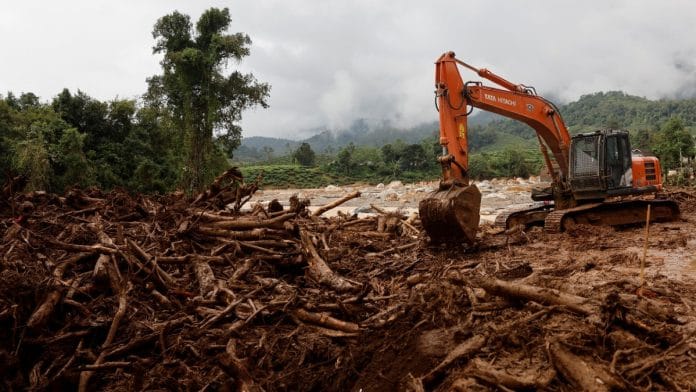New Delhi: The sudden rainfall that triggered landslides in Wayanad on 30 July was made 10 percent more intense due to human-induced climate change, a new study by the World Weather Attribution (WWA) has claimed.
Climate modelling observations by WWA scientists showed that the kind of heavy single-day rainfall event that occurred in Wayanad between 29 and 30 July is expected to occur once every 50 years in today’s climate which is 1.3°C warmer than pre-industrial period.
The WWA is a group of international scientists that study extreme weather events to analyse the role played by climate change in exacerbating the events. This is the WWA’s seventh such study in India and they have conducted around 70 such studies globally.
The study was published on the group’s website Wednesday.
The WWA, in its report, said that the landslides that killed at least 350 people in Kerala were a direct result of extremely heavy rain within a very short period of time — more than 140 mm in 24 hours. The rainfall which fell on already saturated soil led to the debris flow and landslides in Wayanad, India’s 13th most landslide-prone district.
The rainfall on 30 July was the third highest single-day rainfall event in Kerala, after 1924 and 2019, the study noted, citing the India Meteorological Department (IMD).
Conducted by 24 researchers across the world, the study’s results are not yet peer-reviewed because of how quickly it was conducted. However, at a virtual press briefing, climate risk consultant Maja Vahlberg and Arpita Mondal from IIT-Bombay, authors of the study, said that their methodology and climate modelling systems were reliable, robust, and peer-reviewed and had been used in multiple peer-reviewed studies in the past.
Since literature already exists on the landslide susceptibility of hilly districts in Kerala and the role of land-use changes, WWA scientists focused their analysis on understanding the rainfall that caused it and the role played by climate change. They used 16 different regional and global climate modelling systems to understand to what extent, if at all, did global warming play a role in dictating the intensity of rainfall in Wayanad.
Nine out of 16 of the models showed a 10 percent rise in the intensity of the rainfall because of climate change.
“The rainfall that triggered the landslides occurred in a region of Wayanad that has the highest landslide risk in the state. Even heavier downpours are expected as the climate warms, which underscores the urgency to prepare for similar landslides in northern Kerala,” said Vahlberg.
The report claimed that the complex “rainfall-climate dynamics” of mountainous regions, like Wayanad, and the small region of study contributed to a high level of uncertainty in the results. The uncertainty margin in the results ranged from -3 percent to 26 percent.
However, the pattern of extreme single-day rainfall events is in line with a global body of evidence that links climate change and rainfall, said the study.
Also read: Wayanad landslides: Centre blames Kerala for allowing ‘illegal mining, unregulated human habitation’
Increased moisture flux, early warning systems
One of the key observations the WWA team made, supported by previous scientific evidence, is that the increased moisture in the atmosphere also played a role in intensity of the rainfall.
Scientists referred to the Clausius-Clapeyron Equation, a thermodynamics principle, according to which rising temperatures lead to higher moisture or water vapour in the air. Specifically, every 1°C increase in atmospheric warming leads to a 7 percent increase in moisture.
Using historical rainfall data from the IMD and the US-based Climate Prediction Centre, the WWA found that moisture levels in Wayanad on 29 and 30 July, ahead of the landslides, were very high. They also found high Vertically Integrated Moisture Flux (VIMF), the amount of moisture vertically transported in the atmosphere, which is directly related to extreme rainfall events.
This was in line with global findings that heavy rainfall events have become 17 percent more intense since 1980, a period in which the climate has warmed by 0.85°C.
Warmer atmospheric temperatures across the world, induced by fossil-fuel-led climate change, are contributing to heavier downpours, said the study. In a future scenario where global warming is 2°C higher than pre-industrial levels, the study’s models say these one-day heavy rainfall events could be 4 percent more intense than at present.
Issues with rainfall warnings
The study also highlighted that while the IMD had issued extreme rainfall warnings before the landslides, they were at a state level and could not correspond to appropriate action at the district level.
At the press briefing, the authors also mentioned that early warning systems for landslides are in general expensive and difficult to implement, so a more effective strategy would be to reduce landslide risk overall by planting suitable vegetation, reducing erodibility of the soil, and enforcing draining solutions on slopes.
Other factors like the 62 percent decrease in forest cover in Wayanad between 1980 to 2018 and increased quarrying and mining activity in the eco-sensitive zone of the Western Ghats, may have led to increased landslide susceptibility in the region, said the study.
(Edited by Sanya Mathur)
Also read: Landslides hit Wayanad, left it ‘completely isolated’ during Kerala’s Great Flood 100 years ago






